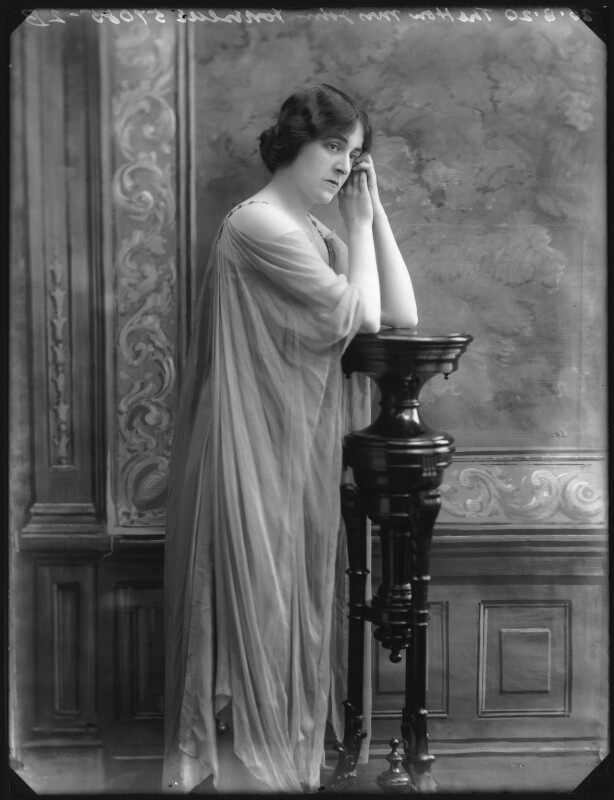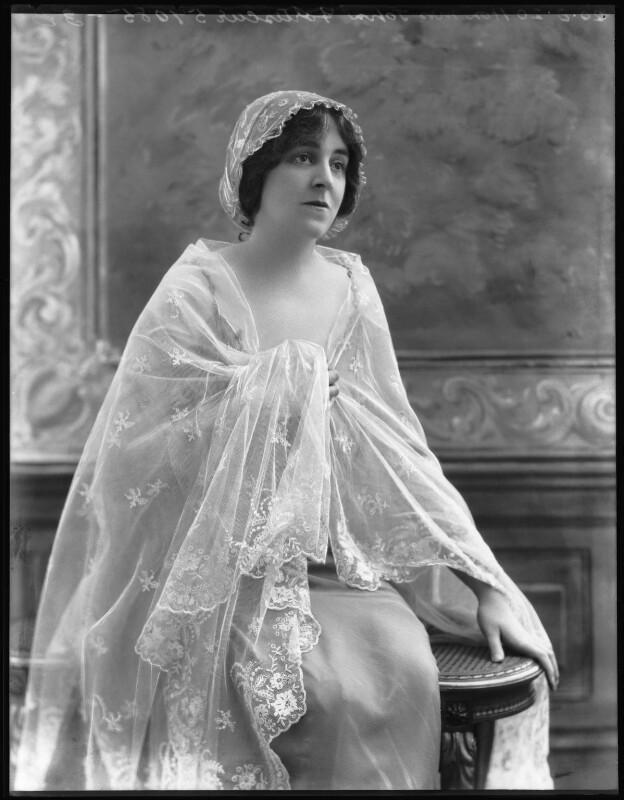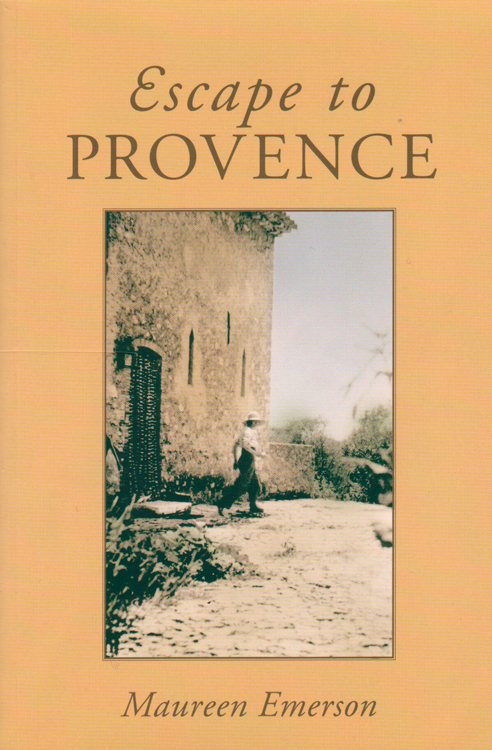
Escape to Provence Published 2008
ISBN 9780955832109
To purchase the Kindle edition from Amazon UK at just £4.80 go to the link at the bottom of this page where you can also read the first chapters of the book – This version does not contain the photos that are in the printed version but you can see them in the gallery, also at the bottom of this page

Escape to Provence is the true story of two remarkable women who, with style and energy, in the tremulous peace between two world wars, carved out new lives for themselves in a village in the South of France. An American from Philadelphia, Elisabeth Parrish Starr a heroine of the Great War, and an Englishwoman, the author Winifred (Peggy) Fortescue, whose memoir Perfume from Provence became a best-seller of the 1930s and ’40s, both escaped to Provence for quite different reasons. Elisabeth as the result of a personal tragedy involving the nephew of President Theodore Roosevelt, and Peggy because she and her husband felt that in Provence ‘one could be poor with dignity’.
After dangerous aid work on the Somme, for which she was decorated by the French government, in 1921 Elisabeth bought an ancient house in Opio, a hill village high above Antibes and Cannes. She called the house the Castello. Here she slowly drew other expatriate friends around her, and, with the now widowed Peggy, lived a bucolic existence. Their hillside would become known to the local people as La Colline des Anglais. The women far preferred their life among the flowers and animals of the hills to the razmatazz of the glittering Riviera, far below. During the years between the wars interesting friends visited Opio. The poet John Betjeman; Eddie Sackville-West, cousin of Vita, stayed with Elisabeth both in Opio and at her coastguards’ cottage near St Tropez, and the beautiful and enigmatic Caroline Paget, the eldest daughter of Charles, the 6th Marquess of Anglesey also came to stay for a short while. Elisabeth fell deeply in love with Caroline, a love which would eventually change the story of their hillside. But Caroline had a very different life in England and would return there to many lovers over the years, including the artist Rex Whistler who was both inspired and tormented by his infatuation with her.

It was at the end of the 1920s that Peggy Fortescue came to Provence, with her husband John, to live in a neighbouring village to Opio. John Fortescue, a younger son of Earl Fortescue of Castle Hill in North Devon, had recently retired as Royal Librarian at Windsor, for which he received his knighthood. But John’s great work, which brought small remuneration, was the thirteen volumes of the History of the British Army. Although he was 28 years older than Peggy, the marriage was an extraordinarily happy one. Peggy herself was the eldest daughter of the Rector of Great Bealings in Suffolk. As a young woman needing to earn her living, Peggy’s path crossed that of Consuelo Vanderbilt, then Duchess of Marlborough, who became her ‘fairy godmother’ and suggested Peggy become an actress to which everyone, rather surprisingly, agreed. Although she had some success with Sir Herbert Tree’s company, her marriage to John curtailed her career on the stage. In order to provide funds to enable John to continue his writing, Peggy began an initially successful couture business in London. Due to the reluctance of the women of high society to honour their bills in good time, this failed after several years. Always plagued by lack of funds, in spite of Peggy’s various energetic efforts to supplement their income, they eventually decided to move to Provence, where life was cheaper and more relaxed. That is until, a year after they had bought their property Britain came off the gold standard and their money problems began once again. John Fortescue was able to enjoy his Provençal home for only about three years for he died as the result of an appendix operation, performed too late.
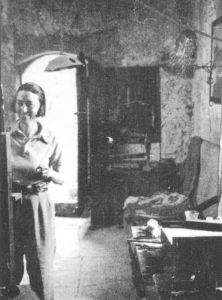
It was around 1934 that Peggy met Elisabeth Starr, and eventually moved to Opio. By now she had written Perfume from Provence, illustrated copiously by the artist E.H. Shepherd, which would sell over 43,000 copies by the end of the 1940s. Her next five books would be about her life and friends in Opio, but particularly about Elisabeth and their adventures together. Like so many of their generation, Peggy and Elisabeth had moved, over a relatively short space of time, from a decorous world of floor-length, corseted dresses, where good behaviour was paramount, to a life in casual trousers, and a fondness for cigarettes and drinking cocktails in hotel bars. In spite of their friendship, they each lived and faced the world virtually alone. In 1939 their strong characters were put to the test as the world crept nearer to another conflict, France mobilised and their tranquil hillside became the Etat Major for the troops defending the frontier with Italy. Prompted by Elisabeth, the women founded an ambitious aid programme for French mobilised soldiers, Elisabeth often setting off into the mountains with her skis in order to set up yet another rest centre in the High Alps.
In June of 1940 as the Germans swept through Holland and into Belgium, Peggy raced to safety in England, where she spent the war years raising funds for the Free French. Here she encouraged the damaged Spitfire pilot, Richard Hillary, to write his acclaimed book The Last Enemy, while Elisabeth fell under the oppressive Vichy regime that affected everyone in the region during the dark years of war. In the early months of 1943, exhausted, she died in her Castello of anaemia and malnutrition, for Provence was the region that suffered most from lack of food during the years of war.
In her Sussex village a distraught Peggy founded an aid programme in Elisabeth’s name: The Elisabeth Starr Memorial Fund for the Children of Provence. When the South of France was liberated by American and French forces, Peggy returned to a Provence that would never be the same again.
Click to enlarge image
These photographs of Winifred Fortescue were taken at the Bassano Studio, London on the 20th August 1920, aged 32 yrs. The original plate images, which are considerably larger and fine quality, are held by the National Portrait Gallery, London and can be viewed at this link.
REVIEWS
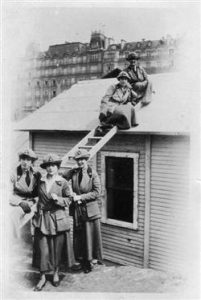
‘An account of expatriate lives in Provence: Maureen Emerson has produced a remarkable book which will captivate any reader with a genuine interest in the history of the Cote d’Azur and of its English-speaking expatriate community’.
Patrick Middleton, The Riviera Reporter.
‘The impact of the war makes for some of the book’s most compelling reading. The author has thoroughly researched her subject and the book paints vivid portraits not just of a beguiling place and a tumultuous era, but of two plucky and unusual women … whose love of Provence changed the course of their lives’.
Vivian Thomas, France Today.
‘Remarkable women’s lives the subject of a fascinating book’.
Dianne Jones, The Mid-Sussex Times.
‘By patiently piecing together the lives of these two women, Maureen Emerson has produced a fascinating portrait of a bygone era and reveals an expatriate community far different from the one that could be seen in the luxury hotels of the French Riviera’.
Nicole Benazeth, LMS News, The Magazine of Sophia Antipolis.
‘Maureen settled back in England eight years ago to be closer to her family but Winifred and Elisabeth were never far from her mind and she has just completed her fascinating book on their lives after eight years of research’.
West Sussex County Times.
‘This is a captivating and sometimes poignant description of a pivotal time. Maureen Emerson, whose French home was in a neighbouring village to the one where Elisabeth and Peggy lived, has researched her subject meticulously. A fascinating history set in a fascinating time.’
Destination France Magazine.
‘Fans of the writings of Winifred Fortescue, whose book Perfume from Provence can perhaps be said to have started the cavalcade of British residents, will be fascinated to read the new biography of her by Maureen Emerson’.
Var Village Voice. 5-star review on Amazon.
‘The reader is given an incredible insight into the two women’s lives together and apart. Their somewhat eccentric lifestyles are a blaze of colour in the already colourful Provence.’
The Riviera Woman Website.
‘I turned to her book and was soon unable to put it down. Elisabeth and Peggy are the main characters in the book, but there is a supporting cast of many other fascinating personalities.’
Canon Roger Greenacre, St Michael’s Messenger, Beaulieu-sur-Mer.
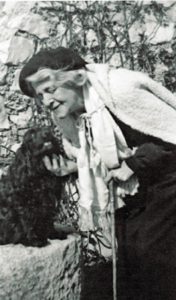
‘There are at least two “Provences”. The French Riviera may, geographically, be a part of Provence, but in the period covered by this nostalgic book, “la Côte d’Azur” – that 120-mile stretch of manicured beaches, pristine marinas and mock “fin de siècle” casinos so familiar from glossy brochures and travel magazines, was a world apart from the “arrière-pays” – the “back country”, whose 30 miles or so of undulating terrain lay between the traffic-clogged coastal roads and the sparsely-populated foothills of the Maritime Alps.
It is this latter Provence that is the setting for “Escape to Provence”, which tells the true story of the lives of two women, one American and one English, from widely differing backgrounds, who, in the early part of the last century, settled in the village of Opio, on olive-groved, lavender-scented slopes on the rural outskirts of Grasse, and over many years, gathered together an expatriate community that became known locally as “La Colline des Anglais” – English Hill. The Englishwoman, Lady Margaret “Peggy” Fortescue, in straitened circumstances following the fall of the pound and, later, the death of her husband, started to write about the region in the hope of subsidising their small income. Her first book, “Perfume from Provence”, became a best-seller, establishing both a new career for Peggy and a fertile literary genre that would be harvested by many later writers, including Kipling, H. G. Wells, Dirk Bogarde, Peter Mayle – and this reviewer.
Although my interest in “Escape to Provence” was originally aroused by the works of Peggy Fortescue – in particular “Perfume from Provence” – it was reinforced by the realisation that the unnamed Provençal village she described in the book was the one to which I too had come to live many years later.
This should not be taken to imply that residence in Opio, or even Provence, is a pre-requisite for the enjoyment of “Escape to Provence”. On the contrary: the author’s evident love for this fortunate region and its fascinating cast of characters shines through every page. It is scrupulously researched, copiously illustrated and should be required reading for anyone visiting the “arrière-pays” ‘.
Ted Jones, The Literary Riviera.
‘The two chief protagonists of this book only knew each other for about seven years. It is therefore less a dual biography, more a portrait of an era seen largely through their eyes. As well as the differing personalities of each woman and their closest friends, there are evocative portrayals, rich in detail, of life during one major conflict, then the more relaxed setting of ‘the back country’, followed by the outbreak of another war. There have been many books about life in Britain during the same age, and I for one found it fascinating to read about a group of English people (and those of other nationalities) who chose to live elsewhere at such a time. The illustrations, of persons and also watercolour paintings, complement the text well too’.
The Bookbag
‘For me, human stories have a much greater impact on historical events. By reading Maureen Emerson’s excellent book, I have been inspired to go deeper and read all of Lady Fortescue’s books and pass them on to a group of my friends who have also caught the ‘Winifred bug’. You can buy them second hand from Amazon and there is an excellent website describing Winifred’s life and each book’.
FR2DAY.com
‘Much has been written about the South of France, but there is still more to be said, as Escape to Provence amply shows. This true story centers around the lives two women, one American and one British, who lived for some time together in the South of France. It’s not quite right to call it a story, more a tapestry of stories about life, love, war, peace, and friendship. The primary characters in Escape to Provence are an American, Elisabeth Parrish Starr, and a British woman, Winifred (Peggy) Fortescue. Their reasons for moving to France were quite different: Elisabeth was a nurse during World War I, while Peggy and her husband moved to Provence more than a decade later, drawn in large part by the then-favorable exchange rate. After her husband’s death, Peggy met Elisabeth and a great friendship was born. The book spans several decades and includes a great deal of background information about the protagonists. In addition, there are stories and anecdotes about many other characters – friends, family, soldiers – which got a little confusing and made me wish I’d kept a list to refer back to as I read. But the heart of the book, the love and friendship and altruism, was well written and inspiring. Set against the backdrop of the South of France, the true stories in Escape to Provence provide a delightful glimpse at the lives of two remarkable women’.
Laura K. Lawless, About.com Guide.

‘Escape to Provence is a factual biography of two women, one English,one American,who lived in the south of France in the first part of the last century. The Englishwoman was Winifred (Peggy) Fortescue,whose book Perfume from Provence was a best-seller of the 1930s and ’40s. She also wrote five other books on her life in England and Provence. Peggy was the wife of Sir John Fortescue, librarian to Edward VII and George V at the Royal Library at Windsor. John Fortescue was also the historian of the British Army, whose work in thirteen volumes earned him the Chesney Gold Medal. Peggy’s close friend, Elisabeth Parrish Starr,was born in Philadelphia.Her life was closely entwined with that of the family of President Theodore Roosevelt. The story follows the two women and the friends they drew around them in Opio, in the hills above Cannes,during the 1930s. Their lives changed forever with the general mobilisation in France, at which point they founded an aid programme Les Foyers des Soldats de France, as their homes became the Etat Major for the defence of the Alpes Maritimes.When the threat of occupation grew, Winifred fled to Sussex, where she spent the war years giving lectures to raise funds for the Free French. Here she befriended the damaged Spitfire pilot,Richard Hillary and it was she who encouraged him to begin writing The Last Enemy. Elisabeth stayed behind in her home in Opio, working with a refugee programme and hiding displaced children. In 1945 Peggy returned to Opio, having launched a Memorial Fund for the Children of Provence in Elisabeth’s name’.
Franco British Council.
Photographs from ‘Escape to Provence’

SAMPLE THE BOOK!

